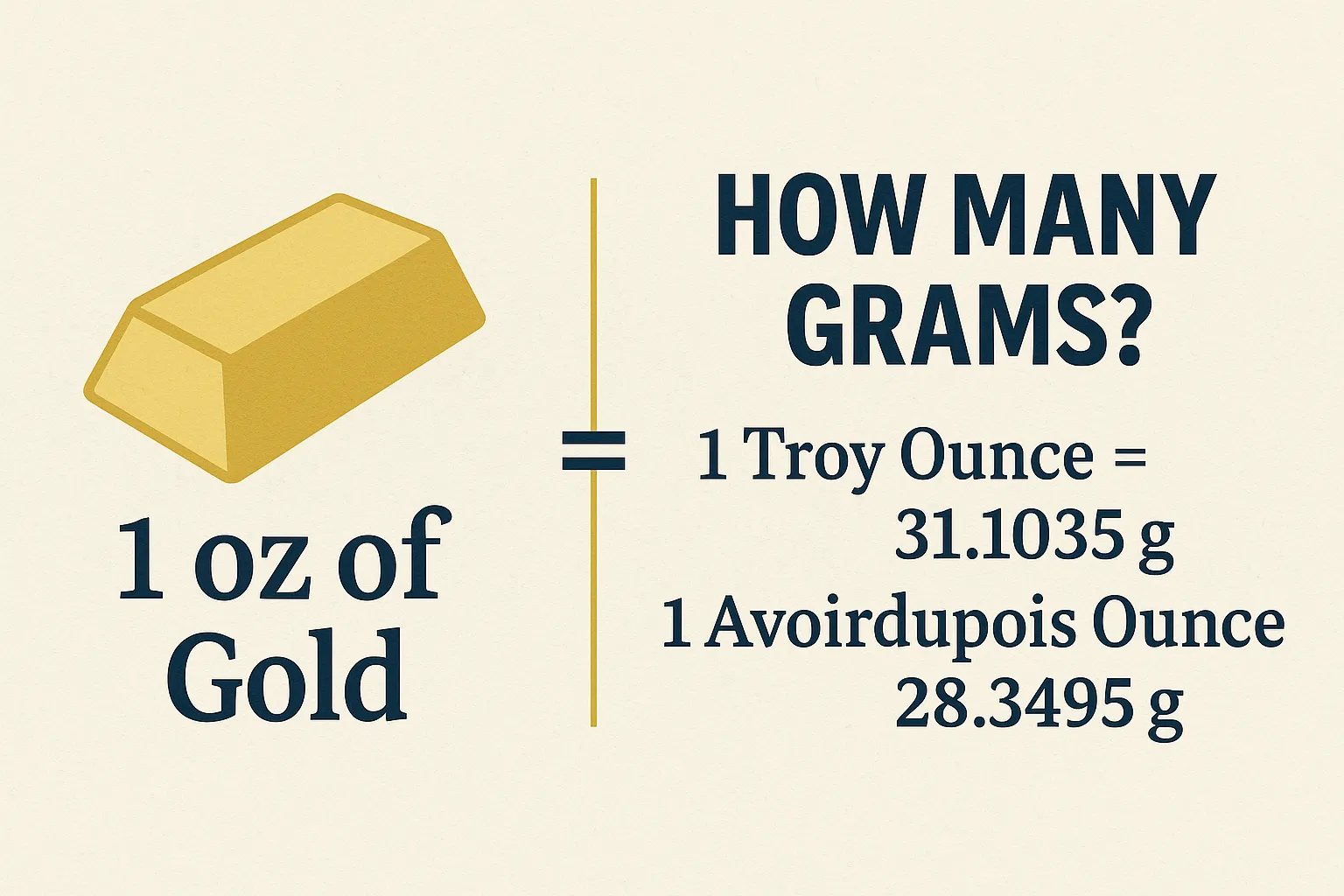1 oz Gold in Grams: 31.1035 g Troy Ounce Explained
1 oz of Gold = How Many Grams?
When you see “1 oz of gold,” your first thought is to wonder that it’s the same ounce you would be using if you were measuring flour or postage stamps. Not with precious metals like gold, however; they use the troy ounce, which is more massive: 1 troy ounce of gold = 31.1035 grams. To put things in perspective, the everyday (avoirdupois) ounce—what’s used for most everyday measurements—weighs 28.3495 grams. This article explains where these numbers come from, why the troy ounce matters to investors, and how to convert between units with ease.
Table of Contents
- What Is an Avoirdupois Ounce?
- What Is a Troy Ounce?
- Comparison: Troy vs. Avoirdupois
- Conversion Formulas
- Why the Difference Matters for Gold
- How to Convert Quickly
- FAQs
What Is an Avoirdupois Ounce?
When you see “1 oz of gold,” your first thought is to wonder that it’s the same ounce you would be using if you were measuring flour or postage stamps. Not with precious metals like gold, however; they use the troy ounce, which is more massive: 1 troy ounce of gold = 31.1035 grams. To put things in perspective, the everyday (avoirdupois) ounce—what’s used for most everyday measurements—weighs 28.3495 grams. This article explains where these numbers come from, why the troy ounce matters to investors, and how to convert between units with ease.
What Is a Troy Ounce?
The troy ounce originated at medieval trade fairs in Troyes, France, and was standardized as the unit for precious metals—gold, silver, platinum—due to its finely divided precision. Its major distinguishing characteristics:
- 1 troy ounce (oz t) = 31.1035 grams
- 12 troy ounces = 1 troy pound (373.2417 grams)
Although the troy pound is no longer generally used, the troy ounce is firmly rooted in bullion markets worldwide.
Comparison: Troy vs. Avoirdupois
| Unit | Abbreviation | Grams |
|---|---|---|
| Avoirdupois Ounce | oz | 28.3495 g |
| Troy Ounce (Precious Metals) | oz t | 31.1035 g |
The troy ounce is about 9.7% heavier than the standard ounce. When buying or selling gold, the market quote will always be in terms of troy ounces.
Conversion Formulas
// To convert between ounces and grams:
Troy ounce → grams:
grams = ounces × 31.1035
Avoirdupois ounce → grams:
grams = ounces × 28.3495
Grams → troy ounces:
troy ounces = grams ÷ 31.1035
Example: How many grams are in 2.5 troy ounces of gold?
2.5 oz t × 31.1035 g/oz t = 77.75875 g
Why the Difference Matters for Gold
- Pricing Precision: Gold is traded in troy ounces on international exchanges (e.g., COMEX, LBMA). A small error can be a fortune when selling large quantities.
- Purity Calculations: Hallmarking and purity (24 K vs. 18 K) are both expressed in troy ounces, so accuracy is conversion ensures you’re receiving exactly the weight and purity you’re paying for.
- Historical Consistency: Gold price histories and records of investment long term are in terms of troy ounces—re-shuffling systems half way would be a disruption to continuity.
How to Convert Quickly
- Mental Shortcut: To approximate, multiply troy ounces by
31.1instead of 31.1035; multiply standard ounces by28.35. - Smartphone Widget: Ounce-to-gram converters are typically available in bullion programs. A simple JavaScript subroutine on your
- Spreadsheet Formula: In Excel or Google Sheets, use
=A2*31.1035(where A2 contains the ounce value).
FAQs
Why is gold priced in the troy ounce rather than the ordinary ounce?
The old gold trade routes used the troy system because it was uniform and pure from region to region. It remains so today the universal standard on bullion markets.
Is the troy ounce used for any other metal?
Yes—silver, platinum, and palladium all are priced in troy ounces. Industrial metals (copper, aluminum) are in metric tonnes or pounds.
Can I mix troy and avoirdupois ounces in recipe making or jewelry production?
No—use one system throughout. If you are doing jewelry in troy ounces, make sure your equipment and alloy weights are the troy standard to ensure purity and weight consistency.




